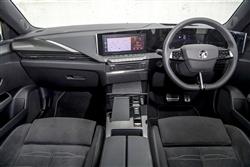Vauxhall Astra - ABC Leasing
How will you view?
This is a sample, showing 30 seconds of each section.
ASTRA ZEN(some text hidden)
By Jonathan Crouch
Ten Second Review word count: 44
The Vauxhall Astra. It's long been the staple of the company car park and this eighth generation version aims to combine this model line's traditional no-nonsense appeal with a bit of extra flair, courtesy of French-derived underpinnings which also bring the option of electrification.
Background word count: 155
For years, Vauxhall has struggled to make its Astra an engaging showroom choice in the family hatchback segment, but perhaps it's time has come. This eighth generation model was the last model in the brand's line-up to move away from the platforms of previous company owner General Motors and adopt the Stellantis Group EMP2 underpinnings and engines used in similarly-sized Peugeots and Citroens. But as you can see from the pictures, it retains very much its own identity. And yes, you'd notice one in the showroom. Which is a definite step forward from an era where an Astra was a choice you made based on price or efficiency. But very rarely on heart or desire. Yes, underneath, it's basically the same as a Peugeot 308 or a DS 4; but you feel here that Vauxhall is at last reinventing itself as a more interesting brand with cars like this one. Let's take a closer look.
Driving Experience word count: 372
It's refreshing to find when you set off down the road in this Vauxhall that an Astra feels significantly different to the Peugeot 308 it's almost entirely based upon. We were hoping it might and had quite high expectations for just how good this eighth generation model might be to drive given that its predecessor was severely under-rated in this regard. True, there's not the rewarding depth of handling prowess that you'd get in this class in a Ford Focus or a Mazda3, but we reckon this Astra still qualifies as best of the rest if you like your driving, mating the fluid gait you get with its Peugeot cousin with a slightly sharper feel. That's partly down to a bit more steering feedback; and partly down to fractionally firmer damping, though this Vauxhall rumbles a little over poorer surfaces as a result. It doesn't feel as troubled by them as the old model did though, partly because of the 14% improvement in torsional stiffness this time round. As for powertrains, well almost all sales will be of the 1.2-litre petrol unit we tried, available with either 110PS or 130PS. Significantly, both are available with the manual gearbox you can't have in a Peugeot 308. That car restricts you to the 8-speed auto transmission also available here, an option with the 130PS petrol Astra. Otherwise, you've to choose between the various levels of electrification that the switch to the EMP2 Stellantis Group platform has made possible here, all of course auto-only. Your starting point is the Turbo Hybrid e-DCT6 variant, which uses a 48V self-charging Hybrid unit with 136PS and a dual-clutch 6-speed auto gearbox with a little 28hp electric motor built into it. Above that, there are two Plug-in Hybrid options based around a 1.6-litre petrol unit which combines with a 110hp electric motor powered by a 12.4kWh battery that can deliver an EAER-rated EV driving range of up to 42 miles. The standard PHEV system output is 180PS, but Vauxhall also offers a performance-orientated GSe variant which boosts that total to 225PS. Your other option is the full-EV Astra Electric, which has a 154hp motor powered by a 400-volt 54 kWh battery with a driving range of around 250 miles.
Pictures (High res disabled)

.jpg)
.jpg)
.jpg)
.jpg)
.jpg)
.jpg)
.jpg)
.jpg)

Scoring
Category: Compact Car
| Performance | |
| Handling | |
| Comfort | |
| Space | |
| Styling | |
| Build | |
| Value | |
| Equipment | |
| Economy | 70% |
| Depreciation | 60% |
| Insurance | 70% |
| Total | 67% |